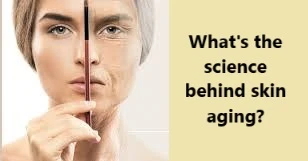What's the science behind skin aging?
What’s the Science Behind Skin Aging?
Skin aging is a complex biological process influenced by both internal and external factors. While aging is a natural part of life, understanding the science behind it helps us take better care of our skin and slow down visible signs such as wrinkles, sagging, and uneven tone. Skin aging occurs in two main ways: intrinsic aging (natural aging) and extrinsic aging (caused by external elements like sun and pollution).
Intrinsic Aging: The Natural Clock
Intrinsic aging, also known as chronological aging, is a slow and inevitable process determined by genetics and the passage of time.
-
Slower Cell Turnover: As we age, the rate at which skin cells renew themselves decreases. Younger skin typically renews every 28 days, but this process can slow to 45–60 days with age, making skin look dull or uneven.
-
Loss of Collagen and Elastin: Collagen gives skin its firmness, while elastin provides elasticity. Starting in your 20s, collagen production declines by about 1% per year. With reduced collagen and elastin, the skin becomes thinner, looser, and more prone to wrinkles.
-
Decreased Oil Production: Sebaceous (oil) glands become less active, especially after menopause. This leads to drier skin and the appearance of fine lines.
-
Reduced Blood Circulation: Slower blood flow contributes to less oxygen and nutrient delivery to the skin, reducing its glow and vitality.
-
Genetics: Your DNA plays a key role in how your skin ages. Some people naturally have thicker dermal layers or better collagen structure, making them age more gracefully.
Extrinsic Aging: Environmental Damage
Extrinsic aging is responsible for most visible signs of skin aging and is driven by lifestyle and environmental factors.
-
UV Exposure (Photoaging): Sun damage is the primary cause of premature aging. UV rays penetrate the skin and break down collagen and elastin fibers, leading to deep wrinkles, leathery texture, sun spots, and uneven pigmentation.
-
Pollution: Airborne toxins and fine particles can lead to oxidative stress, weakening the skin barrier and causing inflammation, pigmentation, and premature wrinkles.
-
Smoking: Nicotine reduces blood flow, depriving the skin of oxygen and nutrients. It also damages collagen and elastin, accelerating sagging and wrinkling.
-
Poor Diet and Lack of Sleep: Nutritional deficiencies and inadequate rest impair the body’s ability to repair skin cells, leading to dullness, puffiness, and inflammation.
-
Repeated Facial Movements: Over time, expressions like squinting or smiling can lead to fine lines, especially around the eyes and mouth.
Can We Slow Skin Aging?
While we can’t stop aging, science-backed strategies can slow its appearance:
-
Use sunscreen daily (SPF 30 or higher)
-
Apply antioxidants (like Vitamin C and E) to fight free radical damage
-
Incorporate retinoids or peptides to boost collagen
-
Stay hydrated and eat a nutrient-rich diet
-
Avoid smoking and manage stress
Conclusion
Skin aging is the result of both natural biological processes and environmental wear and tear. By understanding the mechanisms behind it, we can take proactive steps to protect and nourish our skin—helping it age more gracefully and remain healthy, strong, and radiant over time.

Related Blog
What Causes Oily Skin and Can It Be Managed Naturally? Exploring Root Causes and Gentle Solutions
Aug 2, 2025 by Admin
General
What Are the Signs That You Have Sensitive Skin? Key Symptoms to Help You Identify This Delicate Skin Type
Aug 1, 2025 by Admin
General